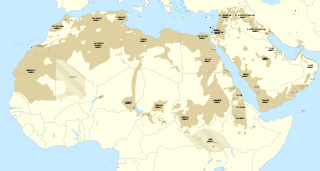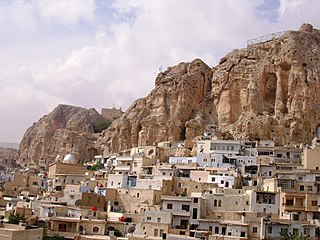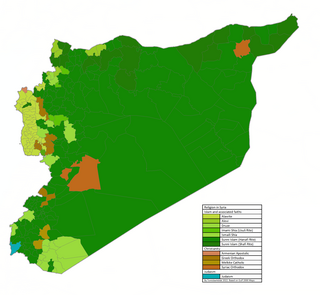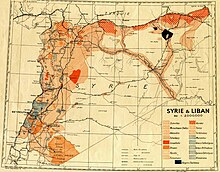Aramaic is a Northwest Semitic language that originated in the ancient region of Syria and quickly spread to Mesopotamia, the southern Levant, southeastern Anatolia, Eastern Arabia and the Sinai Peninsula, where it has been continually written and spoken in different varieties for over three thousand years.

The Iraqi people are people originating from the country of Iraq.

This is a demography of the population of Lebanon including population density, education level, health of the populace, economic status, religious affiliations and other aspects of the population.

The Semitic languages are a branch of the Afroasiatic language family. They include Arabic, Amharic, Aramaic, Hebrew, and numerous other ancient and modern languages. They are spoken by more than 330 million people across much of West Asia, North Africa, the Horn of Africa, Malta, and in large immigrant and expatriate communities in North America, Europe, and Australasia. The terminology was first used in the 1780s by members of the Göttingen school of history, who derived the name from Shem, one of the three sons of Noah in the Book of Genesis.

Syria's estimated pre–Syrian Civil War 2011 population was 22 ±.5 million permanent inhabitants, which included 21,124,000 Syrians, as well as 1.3 million Iraqi refugees and over 500,000 Palestinian refugees. The war makes an accurate count of the Syrian population difficult, as the numbers of Syrian refugees, internally displaced Syrians and casualty numbers are in flux. The CIA World Factbook showed an estimated 20.4m people as of July 2021. Of the pre-war population, six million are refugees outside the country, seven million are internally displaced, three million live in rebel-held territory, and two million live in the Kurdish-ruled Autonomous Administration of North and East Syria.

The Alawites, also known as Nusayrites, are an Arab ethnoreligious group that live primarily in the Levant and follow Alawism, a religious sect that splintered from early Shi'ism as a ghulat branch during the ninth century. Alawites venerate Ali ibn Abi Talib, revered as the first Imam in the Twelver school, as the physical manifestation of God. The group was founded by Ibn Nusayr during the 9th century. Ibn Nusayr was a disciple of the tenth Twelver Imam, Ali al-Hadi and of the eleventh Twelver Imam, Hasan al-Askari. For this reason, Alawites are also called Nusayris.
Western Neo-Aramaic, more commonly referred to as Siryon, is a modern Western Aramaic language. Today, it is spoken by Christian and Muslim Arameans (Syriacs) in only two villages – Maaloula and Jubb'adin, until the Syrian Civil War also in Bakhʽa – in the Anti-Lebanon Mountains of western Syria. Bakhʽa was completely destroyed during the war and all the survivors fled to other parts of Syria or to Lebanon. Western Neo-Aramaic is believed to be the closest living language to the language of Jesus, whose first language, according to scholarly consensus, was Galilean Aramaic belonging to the Western branch as well; all other remaining Neo-Aramaic languages are of the Eastern branch.

Maaloula is a town in the Rif Dimashq Governorate in Syria. The town is located 56 km to the northeast of Damascus and is built into the rugged mountainside at an altitude of more than 1,500m. It is known as one of two remaining villages where Western Neo-Aramaic is spoken, the other one being the nearby smaller village of Jubb'adin. Until the Syrian Civil War, Bakhʽa also had speakers of Western Neo-Aramaic. However, Bakhʽa was completely destroyed during the war, and all the survivors fled to other parts of Syria or to Lebanon.
The Neo-Aramaic or Modern Aramaic languages are varieties of Aramaic that evolved during the late medieval and early modern periods, and continue to the present day as vernacular (spoken) languages of modern Aramaic-speaking communities. Within the field of Aramaic studies, classification of Neo-Aramaic languages has been a subject of particular interest among scholars, who proposed several divisions, into two, three or four primary groups.

Several different denominations and sects of Islam are practised within Syria, whom collectively, constitute approximately 87% of the population and form a majority in most of the districts of the country.

Arabic is the official language of Syria and is the most widely spoken language in the country. Several modern Arabic dialects are used in everyday life, most notably Levantine in the west and Mesopotamian in the northeast.
Syrian Turkmen are Syrian citizens of Turkish origin who mainly trace their roots to Anatolia. Turkish-speaking Syrian Turkmen make up the third largest ethnic group in the country, after the Arabs and Kurds respectively.

Terms for Syriac Christians are endonymic (native) and exonymic (foreign) terms, that are used as designations for Syriac Christians, as adherents of Syriac Christianity. In its widest scope, Syriac Christianity encompass all Christian denominations that follow East Syriac Rite or West Syriac Rite, and thus use Classical Syriac as their main liturgical language. Traditional divisions among Syriac Christians along denominational lines are reflected in the use of various theological and ecclesiological designations, both historical and modern. Specific terms such as: Jacobites, Saint Thomas Syrian Christians, Maronites, Melkites, Nasranis, and Nestorians have been used in reference to distinctive groups and branches of Eastern Christianity, including those of Syriac liturgical and linguistic traditions. Some of those terms are polysemic, and their uses have been a subject of terminological disputes between different communities, and also among scholars.

The Arab world consists of 22 states. As of 2021, the combined population of all the Arab states was around 475 million people.
Western Aramaic is a group of Aramaic dialects once spoken widely throughout the ancient Levant, predominantly in the south, and Sinai, including ancient Damascus, Nabatea, Judea, across the Palestine Region, Transjordan, Samaria as well as Lebanon in the north. The group was divided into several regional variants, spoken mainly by the Nabataeans, Mizrahi Jews, Melkites of Jewish descent, Samaritans and Maronites. All of the Western Aramaic dialects are considered extinct today, except for the modern variety Western Neo-Aramaic, which is still spoken by the Arameans (Syriacs) in the towns of Maaloula and Jubb'adin in Syria.

Religion in Syria refers to the range of religions practiced by the citizens of Syria. Historically, the region has been a mosaic of diverse faiths with a range of different sects within each of these religious communities.

Ethnic groups in the Middle East, in the 'transcontinental' region which is commonly a geopolitical term designating the intercontinental region comprising West Asia without the South Caucasus, and also comprising Egypt in North Africa. The region has historically been a crossroad of different cultures and languages. Since the 1960s, the changes in political and economic factors have significantly altered the ethnic composition of groups in the region. While some ethnic groups have been present in the region for millennia, others have arrived fairly recently through immigration. The largest socioethnic groups in the region are Arabs, Turks, Persians, Kurds, and Azerbaijanis but there are dozens of other ethnic groups that have hundreds of thousands, and sometimes millions of members.
Jubb'adin is a village in southern Syria, administratively part of the Rif Dimashq Governorate, located northeast of Damascus in the Qalamoun Mountains. Nearby localities include Saidnaya and Rankous to the southwest, Yabroud and Maaloula to the northeast, and Assal al-Ward to the northwest.
Syrian Arabic refers to any of the Arabic varieties spoken in Syria, or specifically to Levantine Arabic.
Al-Sarkha, Bakhʽah or Bakhʽa is a former Syrian village in the Yabroud District of the Rif Dimashq Governorate. According to the Syria Central Bureau of Statistics (CBS), Al-Sarkha had a population of 1,405 in the 2004 census. The village, inhabited by Sunni Muslims of Aramean (Syriac) descent, no longer exists as it was completely destroyed during the Syrian Civil War, and all the survivors fled to other parts of Syria or to Lebanon. It was one of the only three remaining villages where Western Neo-Aramaic was spoken, alongside Maaloula and Jubb'adin.













